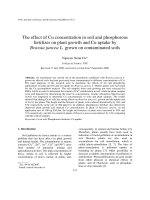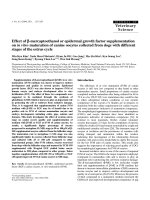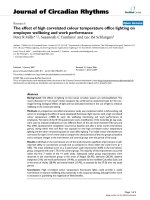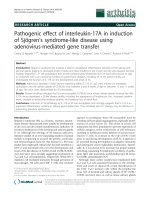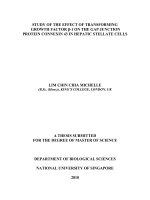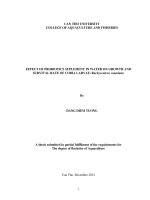Effect of G1705A SNP in Growth Hormone Gene on the Productive and Physiological Performance in Broiler Chicken
Bạn đang xem bản rút gọn của tài liệu. Xem và tải ngay bản đầy đủ của tài liệu tại đây (638.22 KB, 13 trang )
Iraqi Journal of Biotechnology, 2016, Vol. 15, No. 1 , 33-45
Effect of G1705A SNP in Growth Hormone Gene on
the Productive and Physiological Performance in
Broiler Chicken
Bassam G. M. Al-khatib, Dihya H. H. Al-Hassani
University of Baghdad, College of Agriculture, Animal resources department
Received: August 17, 2015 / Accepted: January 28, 2016
Abstract: In this study two commercial broiler hybrids were used (Cobb500 and Hubbard-F15) to
detect the G1705A SNP in the third intron of chicken GH gene and investigate its effect on the productive
and physiological performance in broiler chicken. PCR- RFLP method was used to identify this SNP,
three genotypes were found when using of Eco RV restriction enzyme wild genotype GG, heterozygous
GA and homozygous AA.
Highly significant difference (p<0.01) was found between the distribution of the different genotypes, the
genotype GG had the highest percentage followed by GA then AA and allele G had the superiority over
allele A in both broiler breed, no significant effect of the various genotypes on the productive traits in
both broiler breeds of study, significant effect (p<0.05) of the various genotypes were found on the serum
total protein and triglycerides concentrations of Cobb500 at 14 days of age and the genotypes GG and GA
were gave highest mean followed by the genotype AA.
Keywords: GH gene, PCR-RFLP, Eco RV, G1705A SNP.
Corresponding author: should be addressed (Email: )
Introduction
Poultry industry one of the important
resources of white meats in the country,
which has its crucial position in the
national economy, that contributes to
the achievement of self-sufficiency and
reduce the cost of imported white meat.
The global poultry industry have
witnessed a major development as many
companies have the very high
performance in comparison with other
livestock and aimed to create different
broiler chicken strains and hybrids that
because the low costs of white meat as
compared with red meat. On the other
hand, white meat is nutritional higher in
value than red meat because of the high
content of protein and low levels of fats
and
cholesterol
which
cause
Arteriosclerosis
disease,
obesity,
immunosuppression and leg problems
Kadlec et. al. (1). Nie et. al. (2) pointed
that somatotropic axis genes plays an
important role in chicken growth and
development and this axis consists of
essential components like growth
hormone (GH), insulin-like growth
factors (IGF–I and II) and their
associated carrier proteins and receptors
and other hormones such as insulin,
leptin and thyroid hormones. Some
results from previous studies had
revealed that SNPs of the somatotropic
Iraqi Journal of Biotechnology
axis genes affect growth and
physiological traits Lei et. al. (3).
The chicken growth hormone (GH)
gene is one of the effective genes that
influence the chicken productive and
physiological performance because it
plays a crucial role in growth and
metabolism, it was located at the end of
the long arm of chromosome 27, which
consists of 5 exons and 4 introns and a
length of 4.1 kilo base .The gene
encodes a 191–amino acid mature
protein and a 25–amino acid signal
peptide and the chicken GH gene is
similar to mammalian gene, but the
gene in chickens to be the biggest.
Studies of polymorphisms of GH gene
were carried out by new molecular
technology
such
as
Restriction
Fragment
Length
Polymorphism
(RFLP)
technique
and
DNA
sequencing, molecular studies have
shown that substitution, deletion or
insertion of a single nucleotide due to
changes in a gene, called single
nucleotide polymorphisms (SNPs), it is
a type of DNA polymorphism which is
bi-allelic but extensively distributed
along the chicken genome and recent
investigations of the whole chicken
genome identified over 2.8 million
SNPs Beuzen et. al.,Yan et. al.,Enayati
and Rahimi (4, 5 , 6).
Materials and Methods
This study was conducted at the poultry
farm of animal resources department –
College of Agriculture University of
Baghdad. Two hundred one day-old
chicks were randomly housed in pens
measuring 300 cm wide x 350 cm x 250
cm high (Coob500 and Hubbard
separately) and marked with wing tags.
Birds were kept indoor, on sawdust
litter, in accordance with standard
34
production technology. Commercial diet
was provided ad libitum. While fresh
drinking water was made available at all
times. At one day of age water supplied
with sugar 50gm/litter, vitamin C
0.5gm/litter was provided. Newcastle
B1 Spraying at day one of age and then
Lacota strain was used in drinking
water at (10 , 20 , 30 , 37) days of age ,
and the chicks were vaccinated in
drinking water with Gambaro ( Locard
strain) at 12 and 22 days of age .
Five ml of blood were collected
from the brachial vein of all chicks
under the study. These samples were
collected in EDTA tubes and kept in
freezer (-18 ºC) for DNA extraction by
using DNA extraction kit (Promega,
USA. From blood collected at 14 and 42
day of age, serum was obtained by
putting the blood samples in a clean dry
plain plastic tube and then was allowed
to clot at 37 ºC for 30 minutes before
being centrifuged. The tubes were
centrifuged at 6000 rpm for 5 minutes;
then the serum was collected and kept
in freezer (-18 ºC) until used for serum
biochemical analysis, before DNA
extraction blood volume was reduced to
20 microliters and cell lysis buffer
increased to 500 microliters because all
the blood cells of chicken are nucleated
and contained DNA and proteins levels
in chicken blood higher than in
mammals blood . The primers was
supplied from Alpha DNA/Canada, as
lyophilized powder of different
picomols
concentrations
F-5ʹ
TCCCAGGCTGCGTTTTGTTACTC
3ʹ
and
R-5ʹ
ACGGGGGTGAGCCAGGACTG 3ʹ
gene bank (AY461843) according to
Lei et. al. (3).
Iraqi Journal of Biotechnology
PCR Reaction
The PCR reaction was performed in
0.2ml tubes by mixing master mix
reagents in final volume of 20 μl. The
amplification was performed in a
TECHNE (T-C 5000) thermal cycler
and the reaction mixture was prepared
according to the procedure that
suggested by the manufacture company
(BIONEER, Korea) using 75-90 ng/ μl
of DNA and 0.8 μl of primers and then
complete the PCR reaction volume to
20 μl by distilled water finally reaction
mixture vortexes thoroughly. PCR
mixture without DNA template was
used as a negative control. Thermal
cycle with the following profile: Initial
denaturation at 94 oC for 4 minutes, 35
cycles of 94 oC for 30 seconds,54 oC for
30 seconds,72 oC for 30 seconds and a
final elongation at 72 oC for 5 minutes
PCR products (8µ) were digested with 3
units of EcoRV restriction enzyme at 37
o
C overnight. Restriction pattern were
visualized in a 1.5% agarose gel
electrophoresis stained with Ethidium
bromide.
Productive Traits
Weekly live body weights (grams) were
individually recorded for each chick
during the six week experimental period
and then weekly body weight gains
(grams) were calculated for each chick
under study. At 42 days of age, 15
males and 15 females for each hybrid
were randomly chosen then weighed
and slaughtered after 12 hours of
starvation, immersed in 53°C water for
2 minutes, and plucked in a rotary
drum, chickens heads and legs were
removed. The liver, gizzard, heart were
removed, weighed, then calculated as a
percentage of carcass weight and
35
dressed carcass were weighed and
calculated as percentage of live body
weight. Each carcass was cut into breast
muscle, back, thigh muscle, drumstick,
wings and neck. All weights were
recorded and calculated as a percentage
of live body weight Toghyani et. al. (7).
Serum Biochemical Parameters
Serum GH concentration was measured
by using ELISA Kit provided from
CUSABIO Company and the rest
physiological parameters (total protein,
cholesterol, triglycerides and glucose)
concentrations were measured by an
automatic biochemical analyzer (Accent
200-Poland) following the instructions
of the corresponding reagent kit.
Statistical Analysis
Data were analyzed using Statistical
Analysis System (SAS) (8) to study the
effect of growth hormone (GH) gene
polymorphism
on
various
characteristics
(productive
and
physiological traits). Duncan multiple
range test was used to compare the
average means, Duncan (9).
Results
PCR-RFLP Analysis
Polymerase Chain Reaction (PCR)
amplified regions, which showed a
molecular weight of 429 bp, represents
the region of the growth hormone gene.
This technique was used with primers
for growth hormone gene according to
Nie et. al. (2). To detect the PCR
product, DNA ladder (100-1000) bp
was used and the gel was photographed
by a digital camera. The same PCR
product size was obtained by (2, 3) then
Iraqi Journal of Biotechnology
the PCR products which underwent
restriction digestion with Eco RV
enzyme (GAT/ATC) to detect G1705A
SNP in the third intron of growth
hormone gene and it was able to cut at
this position only when SNP is present
(when G convert to A). The following
fragment sizing patterns were observed
by agarose gel electrophoresis (Figure
1). 1. Wild type GG: No cleavage of the
whole 429 bp segment by Eco RV ( lane
1, 3, 4,6,8,11,13 and 14).
36
2. Heterozygous GA: Eco RV was cut
the sequence to show three fragments in
agarose gel electrophoresis (429 bp ,
312 bp and 117 bp ) ( Lane 2,5,9,12 and
15).
3. Homozygote AA: Eco RV was cut
the sequence to show two fragments in
agarose gel electrophoresis (312 bp and
117 bp). (Lane 7,10).
The results of present study are similar
with previous study of Nie et. al. and
Lei et. al. (2,3) on the Chines chicken.
Figure (1): PCR product digested with Eco RV electrophoresis on 1.5%. Lane M: DNA ladder
(100-1000). Lane1,3,4,6,8,11,13 and 14 : Wild type GG genotype 429 bp, Lane2,5,9,12 and 15:
heterozygote GA genotype 429, 312 and 117bp, Lane 7 and 10: Homozygote AA genotype 312 and
117 bp .The (RFLP) products were agarose gel at 5 volt/cm2 for 1hour. Visualized under U.V light
after stain with Ethidium Bromide
Genotype Distribution
It is obvious from table (1) that there
were high significant differences
(p<0.01) in the genotype GG of growth
hormone gene followed by GA and then
AA amounted 47.06, 45.88 and 7.06 %
in Cobb500 and in Hubbard 61.05,
36.84 and 2.11% respectively. The
results of the present study are similar
to previous results which were obtained
from Nie et. al., Lei et.al. (2,3) who
used Eco RV endonuclease enzyme to
detect the G1705A SNP in the third
intron of GH gene in the Chinese
chicken.
37
Iraqi Journal of Biotechnology
Table (1): Distribution of growth hormone gene genotypes (No. and %) of Cobb500 and Hubbard
Cobb 500
Hubbard F-15)
No. (%)
No. (%)
GG
40 (47.06)
58 (61.05)
GA
39 (45.88)
35 (36.84)
AA
6 (7.06)
2 (2.11)
Total
85 (100)
95 (100)
Chi-square value (χ2)
10.359 **
12.071 **
Genotype
** (P<0.01)
F-15 broiler chicken
The results of this study are agreed with
previous studies of Nie et. al., Lei et. al.
(2,3) which refers to the dominance of
allele G over allele A of the SNP
G1705A in the third intron of GH gene
in the Chines chicken.
Allele Frequency
According to Hardy–Weinberg low the
results of table (2) showed superiority
of allele G over allele A amounted 0.70
and 0.30 for Cobb500 respectively and
in Hubbard (0.79 and 0.21) respectively.
Table (2): Allele frequency of Growth hormone gene in Cobb500 and Hubbard F-15 broiler
chickens
Genotype
Cobb 500
HubbardF-15
G
0.70
0.79
A
0.30
0.21
Total
100%
100%
The Association of G1705A SNP with
Weekly Live Body Weight
Table (3) showed non-significant
differences between the various
genotypes (GG, GA and AA) of the
growth hormone gene in the mean of
weekly live body weight for Cobb500
and Hubbard during the experiment
period.
38
Iraqi Journal of Biotechnology
Table (3): Effect of Growth hormone gene polymorphism on weekly live body weight (g)
Body
Weight
(gm/week)
Cobb500
GG
Hubbard F-15
GA
a
AA
a
GG
a
GA
a
AA
a
a
1
167.25 ± 2.9
164.87± 2.1
a
165.83 ± 4.5
a
155.08± 1.9
a
158.71± 2.4
a
147.5 ± 12.5
a
a
2
420.62 ± 7.0
430.89± 6.5
a
417.5 ± 23.3
a
438.96 ± 5.3
a
447.42 ± 6.2
a
425 ± 3.5
a
a
3
904.62 ± 12.4
a
918.71 ± 13.7
896.66± 30.3
a
891.89 ± 10.4
a
906.71 ±11.6
a
877.5 ± 62.5
a
a
4
1463.75±23.2
a
1486.67±23.7
1428.33±37.3
a
1423.41±19.1
a
1432 ± 23.1
a
1287.5 ± 77.5
a
a
5
1928.0 ± 31.0
a
1962.69±34.4
1877.5±62.3
a
1946.64±29.3
a
1994.5±34.2
a
1790.0 ± 4.0
a
a
6
2569.38±53.1
2603.08±48.6
2544.17±91.2
2596.64±39.3
2609.14± 48.1
2490.0 ± 12.5
Means with different superscripts within each bread are significantly different at 0.05 level
The Association of G1705A SNP on
the Mean of Weekly Weight Aain
Results of table (4) showed nonsignificant differences between the
various genotypes (GG, GA and AA) of
the growth hormone gene in the mean
of weekly weight gain for Cobb500 and
Hubbard during the experiment period.
39
Iraqi Journal of Biotechnology
Table (4): Effect of Growth hormone gene polymorphism on weekly weight gain (g)
Cobb500
Weight gain
(gm/week)
GG
HubbardF-15
GA
a
AA
a
GG
a
GA
a
AA
a
a
1*
93±2.3
89.10±1.9
a
93.33±4.4
a
89.44±1.6
a
92±2.0
a
90±1.0
a
a
2
253.37±5.6
266.02±5.5
a
251.66±21.0
a
283.87±4.1
a
288.7±4.3
a
277.5±22.5
a
a
3
484±8.4
487.82±8.3
a
479.16±11.8
a
452.93±6.2
a
459.28±6.5
a
452.5±27.5
a
a
4
559.12±13.5
567.94±11.6
a
531.66±17.9
a
531.51±10.8
a
525.28±13.2
a
528±1.5
a
a
5
464.25±18.3
476.02±16.1
a
449.16±36.3
a
523.22±16.6
a
562.57±19.1
a
502.5±37.5
a
a
6
641.37±35.1
640.38±33.2
666.66±32.8
650±20.5
614.57±28.7
700±8.5
Means with different superscripts within each bread are significantly different at 0.05 level.
*weight gain was measured from age 3 -7 days
Effect of G1705A SNP on the Live
and Carcass Weight, Dressing and
Dressing with Giblets
Results of table (5) showed insignificant
differences between the different
genotypes (GG, GA and AA) of the
growth hormone gene in the (live body
and carcass weight, dressing and
dressing with giblets percentage) for
Cobb500 and Hubbard during the
experiment period.
40
Iraqi Journal of Biotechnology
Table (5): Effect of Growth hormone gene polymorphism on live and carcass weight, dressing and
dressing with giblets
Cobb500
HubbardF-15
Traits
GG
Live weight
(g)
Carcass
weight (g)
GA
a
2685.40±94.5
a
2606.7±47.8
a
2037.70±69.7
AA
a
2700±25.0
a
1987.33±43.4
a
GG
a
2751.8±76.1
a
2053±7.5
a
GA
a
2518±51.3
a
2201.43±63.8
a
AA
a
2638.8±99.9
a
1979.3±44.4
a
a
2078±82.4
a
a
Dressing (%)
75.92±0.4
Dressing
with giblets
(%)
76.20±0.5
a
80.17±0.4
76.03±0.9
a
80.40±0.5
79.99±0.6
a
79.64±0.7
78.6±0.2
a
83.96±0.6
78.72±0.5
a
82.80±0.3
a
82.90±0.3
Means with different superscripts within each bread are significantly different at 0.05 level
Effect of G1705A) SNP on Relative
Weight of Carcass Cuts and Giblets
The results of Table (6) showed
insignificant differences between the
different genotypes (GG, GA and AA)
of growth hormone gene in the relative
weights of all studied traits for each
hybrids .The high correlation between
the relative weight of the cuts and
giblets with the insignificant effect of
the various genotypes on the live body
weight and carcass weight led to
insignificant effect on the traits above.
41
Iraqi Journal of Biotechnology
Table (6): Effect of Growth hormone gene polymorphism on relative weight of carcass cuts and
giblets
Cobb500
Traits
(%)
GG
Hubbard F-15
GA
AA
GG
GA
AA
a
a
a
a
a
a
14.06±0.30
13.67±0.42
13.52±0.41
14.54±0.44
14.27±0.76
14.16±0.17
a
a
a
a
a
a
11.62±0.33
11.87±0.29
12.07±0.65
13.35±0.27
13.04±0.28
12.76±0.21
a
a
a
a
a
a
9.35±0.21
9.42±0.24
10.11±0.64
9.72±0.18
10.05±0.27
9.96±0.11
a
a
a
a
a
a
5.38±0.31
5.73±0.41
6.33±0.99
5.52±0.17
5.32±0.24
5.29±0.21
a
a
a
a
a
a
21.43±0.52
21.24±0.65
18.63±0.67
22.40±0.43
22.14±0.60
22.42±0.70
a
a
a
a
a
a
36.72±0.76
35.73±0.54
38.35±3.14
32.50±0.55
32.38±0.67
32.31±0.36
a
a
a
a
a
a
0.47±0.02
0.50±0.02
0.45±0.04
0.51±0.02
0.52±0.02
0.52±0.03
a
a
a
a
a
a
2.33±0.03
2.24±0.10
1.91±0.28
2.20±0.08
2.27±0.05
2.36±0.17
a
a
a
a
a
a
1.50±0.05
1.46±0.04
1.33±0.01
1.34±0.05
1.45±0.05
1.41±0.17
Thighs
Drum stick
Wings
Neck
Back
Breast
Heart
Liver
Gizzard
Means with different superscripts within each bread are significantly different at 0.05 level
Effect of G1705A SNP on Some
Serum Biochemical Parameters of
Coob500
Results of table (7) showed significant
differences (p<0.05) in the total protein
concentration of chicken blood serum at
14 days of age where the genotypes GA
and GG had higher mean amounted 3.2
g/dl as compared with the genotype AA
which recorded 2.6 g/dl. Also had been
observed a significant differences
(p<0.05) in triglycerides concentration
at 14 days of age amounted in genotype
AA 123 mg/dl and then followed by GA
and GG amounted 121.7 mg/dl . While
there were no significant effect for
various genotypes in the rest traits
above at 14 and 42 days of age.
42
Iraqi Journal of Biotechnology
Table (7): Effect of growth hormone gene polymorphism per age in some serum biochemical
parameters of Cobb500
14 days
42 days
Traits
GG
GA
a
AA
GG
a
2166±5.4
2173.4±1.1
a
a
a
GH (pg/ml)
2173±4.0
a
GA
1784.6±40.1
a
AA
a
1826±1.57
a
a
1826±3.00
a
a
GHR (mg/l)
0.97±0.00
Total protein
(g/dl)
Triglyceride
(mg/dl)
Cholesterol
(mg/dl)
0.97±0.00
a
3.2±0.06
0.99±0.01
a
3.2±0.12
b
121.7±0.23
2.6±0.0
121.7±0.23
121.4±0.27
b
a
a
a
a
123.0±0.0
121.5±0.26
1.28±0.003
3.3±0.8
b
a
1.28±0.00
a
3.3±0.19
66.4±0.43
121±0.50
a
a
a
2.9±0.0
65.9±0.56
113.6±1.65
a
a
a
a
1.26±0.01
a
64.50±0.50
a
112.8±0.26
a
a
112±0.0
a
a
Glucose (mg/dl)
229.7±0.19
229.9±0.20
229.2±0.40
228.9±0.16
228.6±0.17
228.5±0.45
Means with different superscripts within each bread are significantly different at 0.05 level
Effect of G1705A SNP on Some
Serum Biochemical Parameters of
Hubbard F-15
It was seen from table (8) insignificant
differences between the genotypes
(GG,GA and AA) of GH gene in their
effects on (GH , GHR , total protein ,
triglycerides , cholesterol and glucose)
concentrations in blood serum at 14 and
42 days of age .
43
Iraqi Journal of Biotechnology
Table (8) Effect of growth hormone gene polymorphism per age in some serum biochemical
parameters of Hubbard F-15
14 days
42 days
Traits
GG
GA
a
AA
GG
a
a
GA
a
AA
a
a
GH (pg/ml)
2170.4±1.95
1888.6±184.6
a
2176±1.00
a
1825.3±0.72
a
1823.4±1.02
a
1829±9.0
a
a
GHR (mg/l)
0.97±0.01
Total protein
(g/dl)
Triglyceride
(mg/dl)
Cholesterol
(mg/dl)
0.98±0.01
a
3.3±0.09
0.99±0.01
a
3.4±0.14
a
123±0.19
3.1±0.10
122.9±0.31
124.4±0.53
a
a
a
3.1±0.09
123±0.0
123±0.61
3.5±0.14
60.4±0.23
119.5±0.45
3.2±0.30
60.2±0.31
120±0.55
a
a
a
a
1.27±0.01
a
a
a
a
1.29±0.01
a
a
a
a
1.28±0.01
a
60.4±1.4
a
120.6±0.61
a
a
122±0.01
a
a
Glucose (mg/dl)
230±0.25
228.6±0.17
229.3±0.40
228.8±0.17
228.6±0.17
228.5±0.45
Means with different superscripts within each bread are significantly different at 0.05 level
Discussion
Johnson et. al. (10) found that GH
concentrations were not correlated with
growth rate. Actually, selection for
higher growth rate resulted in lower
basal GH concentrations and this
conclusion led to conclude the
abundance of GHR limits growth
especially during the active growth
phase of the young chicken and the
growth selected chickens, expressed
higher levels of GHR. These results
were different from the previous studies
Nie et. al.,Lei et. al. (2.3) about the
significant effect of the SNP G1705A in
intron 3 of GH gene and it had positive
correlation with meat quality and live
body weight of the different strains of
the Chinese chicken where the genotype
AA and GA recorded significant
increase as compared with the genotype
GG at the different ages of the study.
The difference in the results of this
study with the previous results caused
by the difference in the studied sample
size as well as the difference in the
studied breeds and conditions of the
experiment.
The
non-significant
differences in the body weight between
the various genotypes of SNP G1705A
in the third intron of GH gene led to the
absence of differences between the
various genotypes in the trait of body
weight gain and these results were
disagreed with the previous study Nie
Iraqi Journal of Biotechnology
et. al., Lei et. al. (2,3) in the Chines
chickens.
The insignificant differences in the live
body weight, carcass weight, dressing
and dressing with giblets caused by
insignificant effect of various genotypes
for each hybrids under study (GG, GA
and AA) on the live body weight and
body weight gain. The results of this
study were disagreed with Ghelghachi
et. al. (11) who referred to significant
effect of the GH gene polymorphism on
the productive performance of Arian
broiler with increase in live body weight
and carcass weight as compared to wild
genotype. The difference of present
study with the others may be because of
the difference of broiler hybrids,
number of study birds and experiment
conditions like environment.
Bingxue et. al.(12) referred to
significant effects of mutation G to A in
the third intron of GH gene diagnosed
by endonuclease enzyme Eco RV on the
breast muscle weight in the Chines
chicken. Also Ghelghachi et. al. (11)
pointed to the significant effects of GH
gene polymorphism on the relative
weights of breast muscle, drum stick,
wings and lean in Arian broiler.
The environmental factors may be
affecting directly or indirectly the
growth hormone gene expression which
affects the effectiveness and impact on
the body or target tissue, led to the
difference between the results of this
experiment and other results in a
different environment.
These differences in blood serum total
protein concentrations between the
various genotypes caused by the crucial
role played by GH in stimulation of
protein synthesis through reducing
proteolysis and decreasing protein
oxidation leading to a net increase in
protein accretion Bell et.al. (13).The
44
significant effect of GH gene
polymorphism in serum triglycerides
concentration caused by the important
role of GH in lipids metabolism, which
is characterized by lipogenic effect.
Evidence for a lipogenic effect of GH
was presented by Proudman et.al. (14)
who found that hypophysectomized
turkey pullets had lower plasma
triglyceride levels compared to that of
their intact counterparts, and GH
administration
to
the
hypophysectomized animals elevated
circulating triglyceride levels. In vitro
evidence for a direct lipogenic action of
GH could be found in the observation
that GH promotes acetate incorporation
into liver lipids Cupo and Cartwright
(15).
The reason of insignificant effects
between the various genotypes in the
above traits may be because of the
intensive selection programs for the
rapid growth leading to a negative
correlation or lack of correlation in the
effect of growth hormone gene with the
(productive, physiological) traits and
growth represented by increasing the
number and size of body cells and the
physiological characteristics represented
by the different metabolic processes in
the body of bird Decuypere et. al. (16).
Also Buyse et. al. (17) showed the
importance of the secretion pattern, time
and age of growth hormone in the
growth and metabolism of birds.
References
1.
2.
Kadlec, J.; Hosnedlová, B.; Rehout,V.;
Čítek, J.; Večerek, L. and Hanusová, L.
(2011). Insulin-Like Growth Factor-I Gene
Polymorphism and its Association with
Growth and Slaughter Characteristics in
Broiler Chickens. J. Agrobiol., 28(2): 157–
163.
Nie, Q.; Lei, M.; Ouyang, J.; Zeng, H.;
Yang, G. and Zhang, X. (2005).
Iraqi Journal of Biotechnology
3.
4.
5.
6.
7.
8.
9.
10.
11.
12.
13.
Identification and characterization of single
nucleotide polymorphisms in 12 chicken
growth-correlated genes by denaturing high
performance liquid chromatography. Genet.
Sel. Evol., 37:339–360.
Lei, M.; Luo, C.; Peng, X.; Fang, M.; Nie,
Q.; Zhang, D.; Yang, G. and Zhang, X.
(2007). Polymorphism of Growth-Correlated
Genes Associated with Fatness and Muscle
Fiber Traits in Chickens. Journal of Poultry
Science, 86: 835-842.
Beuzen, N. D.; Stear, M. J. and Chang, K. C.
(2000). Molecular Markers and their use in
Animal Breeding.Vet. J.,160: 42–52.
Yan, B.; Deng, X.; Fei, Q.; Hu, X.; Wu, C.
and Li, N. ( 2003). Association between
single nucleotide polymorphisms of the
chicken growth hormone gene and chicken
growth and carcass traits.Sci. Bull. Sin.,
48:1304–1307.
Enayati, B. and Rahimi-Mianji, G. (2009).
African Journal of Biotechnology., 8 (14):
3154-3159.
Toghyani, M.; Tohidi, M.; Gheisari, A. and
Tabeidian, A. (2012). Evaluation of Oyster
Mushroom (Pleurotus ostreatus) as a
Biological
Growth
Promoter
on
Performance, Humeral Immunity, and Blood
Characteristics of Broiler Chicks. J. Poult.
Sci., 49: 183-190.
SAS. (2012). Statistical Analysis System,
User's Guide. Statistical. Version 9.1th ed.
SAS. Inst. Inc. Cary. N.C. USA.
Duncan, D.B. (1955). Multiple Rang and
Multiple F-test. Biometrics., 11:4-42.
Johnson, R.J.; McMurtry, J.P. and Ballard,
F.J. (1990). Ontogeny and secretory patterns
of plasma insulin-like growth factor-I
concentrations in meat-type chickens. J.
Endocrinol., 124: 81-87.
Ghelghachi, A. A.; Seyedabadi, H. R. and
Lak, A. (2013) . Association of growth
hormone gene polymorphism with growth
and fatness traits Arian broilers. Int. J.
Biosci., 3:216-220.
Bingxue,Y.; Xuemei, D.; Jing, F.;
Xiaoxiang, H.; Changxin, W. and Ning, L.
(2003). Single nucleotide polymorphism
analysis in chicken growth hormone gene
and its associations with growth and carcass
traits.Chinese Science Bulletin.,48:15611564.
Bell, A.W.; Bauman, D. E.; Beermann, D.
H. and Harrell, R. J. (1998). Nutrition,
development and efficacy of growth
14.
15.
16.
17.
45
modifiers
in
livestock
species.
J.
Nutr.,128:360–363.
Proudman, J. A.; McGuinness, M.C.;
Krishnan, K.A. and Cogburn, L.A. (1994).
Endocrine and metabolic responses of intact
and hypophysectomized turkey poults given
a daily injection of chicken growth hormone.
Comp. Biochem. Physiol., 109:47–56.
Cupo, M.A. and Cartwright, A.L. (1989).
Lipid synthesis and lipoprotein secretion by
chick liver cells in culture: influence of
growth hormone and insulin-like growth
factor-I. Comp. Biochem. Physiol., 94:355–
360.
Decuypere, E.; Leenstra, F.R.; Buyse, J. and
Berghman, L. (1991). Temporal secretory
patterns of growth hormone in male meattype chickens selected for body weight gain
or food conversion. Br. Poult. Sci., 32:1121–
1128.
Buyse, J.; Leenstra, F.R. ; Beuving, G. ;
Berghman, L. R. and Decuypere, E. (1994).
The effect of environmental temperature on
episodic growth hormone release of meattype chickens selected for 6 wk body weight
gain or for improved feed efficiency
between 3 and 6 wk of age. Gen. Comp.
Endocrinol., 95:416 –421.
